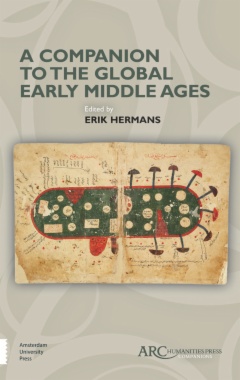This companion introduces the connections between early medieval societies that have previously been studied in isolation. By bringing together nineteen experts on different regions across the globe, from Oceania to Europe and beyond, it transcends conventional disciplinary boundaries and synthesizes parallel historiographical narratives. The period 600-900 CE witnessed important historical developments, such as the establishment of a Southeast Asian thalassocracy by the Shailendra dynasty and the expansion of the Frankish polity under Charlemagne on the far ends of Eurasia and the consolidation of the Abbasid and Tang empires in between. A Companion to the Global Early Middle Ages integrates these contemporaneous processes and presents new insights into a neglected phase of world history.
- Cover
- Half-title
- Series information
- Title page
- Dedication
- Copyright information
- Table of contents
- Maps
- Acknowledgments
- Introduction
- Macrohistorical Narratives
- Eurocentrism
- Chronology
- Connectivity
- Global History vs Globalization
- Organization of Chapters
- Acknowledgements
- Bibliography
- Part One Regions
- Chapter 1 East Africa
- Introduction
- The Cultural Geography of the Region
- The Zanzibar Archipelago
- Islamization of East Africa
- Madagascar
- The Comoros
- Southern Africa
- Africa and Indian Ocean Globalizations
- Eastern Africa in the “Age of Emporia”
- Asia and the Underdevelopment of Africa?
- Bibliography
- Chapter 2 South Asia
- Central India, 600–800 CE: The Chalukya Realm
- South India, 600–800 CE: The Consolidation of the Pallava Dynasty
- South India, 700–800: The Rise of the Cholas and Bhakti Devotionalism
- Layered Communities in Chola-Era South India
- Kancipuram: An Early Medieval Hub of Commerce and Religion
- Wider Indian Ocean Context
- Bibliography
- Chapter 3 Southeast Asia
- Power, 650–750 CE
- Beliefs: Hindu and Buddhist
- Power, 750–850 CE
- Acknowledgements
- Bibliography
- Chapter 4 Oceania
- Introduction
- Settlement History: A Summary
- Melanesia
- Mainland Papua New Guinea
- Bismarck Archipelago and Island Melanesia
- Polynesia
- Western Polynesia
- Eastern Polynesia
- Micronesia
- Conclusion
- Bibliography
- Chapter 5 Japan
- Cosmopolitan Japan in the Northeast Asian Cultural Sphere
- Changing the Capitals: The Traditional Movable Japanese Court
- Fujiwarakyo¯: The First Chinese-Style Capital in Japan
- Emperor Sho¯mu’s Peregrination: Nara, Naniwa, Kuni, Shigaraki
- Emperors Ko¯.nin and Kanmu: Nagaokakyo¯ and Heiankyo¯
- Conclusions
- Bibliography
- Chapter 6 Korea
- Strengthening Autocratic Rule through Buddhist Symbolism and Confucian Statecraft
- Fostering Relations through Diplomacy, Trade, Tribute, and Immigration
- Bolstering of the System for Educating Nobles through Confucian Learning
- Conclusion
- Bibliography
- Chapter 7 China
- The Tang in a Nutshell
- Tang Worldview
- Tang and the World
- Eastern Türks
- The Western Regions
- East Asia
- Conclusion
- Bibliography
- Chapter 8 Tibet
- Introduction
- The Beginning of the Tibetan Empire
- The North
- The Northeast
- The East
- The Southeast
- The West
- Buddhism as a State Religion
- Dunhuang and the Lasting Influence of the Tibetan Empire
- Acknowledgements
- Bibliography
- Chapter 9 Inner Asia
- The First Türk Empire, 552–630
- Türk Submission to China, 630–682 CE
- The Second Türk Empire, 682–742 CE
- The Uyghur Empire, 744–840 CE
- Conclusion
- Bibliography
- Chapter 10 West Asia
- Introduction
- The Sasanian– Byzantine Prelude
- Islam: From Conquest to Empire
- From the ʿAbbāsid Revolution to the Rise of the Peripheries
- Conclusion
- Bibliography
- Chapter 11 Byzantium
- Military Conflicts with Neighbouring Polities
- Trade and Diplomacy with the Wider World
- Microbial Exchange
- Conclusion
- Bibliography
- Chapter 12 Northeast Africa
- Introduction
- Geographical and Linguistic Background
- A Common Faith: Christianity in Ethiopia and Nubia
- A Nubian Renaissance
- An Ethiopian Dark Age?
- Conclusion
- Acknowledgements
- Bibliography
- Chapter 13 Sahara and West Africa
- Introduction
- TransSaharan Contacts in the Early Middle Ages
- Gold and Slaves
- Consequences of the Early Medieval TransSaharan Trade
- Bibliography
- Chapter 14 Western Europe
- Charlemagne’s Empire in Global Perspective “A Great Wealth of Gold, Silver, and Even Gems”
- From the Roman to the Carolingian Empire
- Charlemagne’s Elephant
- “Until Then They Had Seemed Almost Impoverished”
- Windows to a Wider World
- Acknowledgements
- Bibliography
- Chapter 15 Mesoamerica
- The Americas: An Overview
- The Maya before the Early Middle Ages
- Late Classic Maya, 600– 800 CE
- LandBased Trade
- Maritime Trade
- The Collapse of Southern Lowland City-States in the Ninth Century
- International Commerce in the Ninth Century
- Summary
- Bibliography
- Part Two Processes
- Chapter 16 Trade and Commerce
- Introduction
- The Economy of Tang China
- The Origins of the Caliphate
- The Economy of the Umayyad Caliphate
- The Heyday of Tang–.Abba¯sid Trade
- Trade Systems
- Two New North–South Systems
- The Golden Age
- The Decline of Tang–.Abba¯sid Trade
- Bibliography
- Chapter 17 Migration
- The “End” of the Period of “Barbarian Invasions” around 600 CE
- Elite and Imperial Mobility
- Religious Mobility and Migration
- Mercantile Mobility and Migration
- Refugees, Deportees, and Slaves
- Migrations on and under the Radar of Historians
- Bibliography
- Chapter 18 Climate and Disease
- Introduction
- The City of the Three Pyramids
- “A Most Dread Portent”
- “Heavy Trouble in Europe”
- Instability on the Steppe
- Dust Veils and Disease
- “The Encircling Presence of Death”
- Cataclysm and Mentalités
- Conclusion: Disruption and Renewal
- Bibliography
- Chapter 19 Intellectual Connectivity
- The Limited Diffusion of Higher Learning
- Religious Epistemic Networks
- Cross-Cultural Transmission of Knowledge
- Bibliography
- Index

